
A $464 Million Budget Couldn’t Prevent January 6th Breach of the U.S. Capitol
January 3, 2022
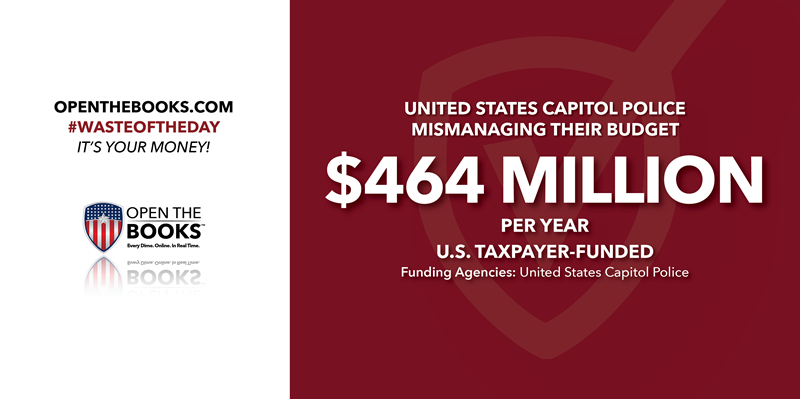
Some United States Capitol Police (USCP) officers were teleworking, some riot gear was locked in a bus or shattered upon impact after being improperly stored, and only a couple hundred of the 1,879 sworn officers were inside the Capitol Building, despite intelligence showing the protests might get heated on January 6th, 2021.
Even with a $464 million-a-year budget and nearly 2,000 officers, the USCP was unable to stop a breach of the Capitol by protestors who carried no guns. We first broke our deep dive investigation at Forbes, here.
The USCP’s budget is greater than many large metropolitan cities, including Detroit, Minneapolis, St. Louis, and Columbus, Ohio.
Showing Up Is Half the Battle
Despite employing 1,879 sworn officers as of September 2020, a congressional inquiry forced USCP to admit that on January 6th, only 195 officers were deployed to interior or exterior posts at the U.S. Capitol and 276 more were assigned to the Department’s seven civil disturbance unit platoons.
USCP documents show that at 2pm on that day, only 1,214 officers were “on site” across the Capitol complex of buildings. Congressional investigators concluded, however, that USCP could only account for 417 officers and could not account for the whereabouts of the remaining 797 officers.
Only 1,457 of its 1,879 sworn officers were ever “on site” over the entire 24-hour period of January 6th. That leaves 422 officers who were never even on site – 23-percent or nearly 1 in every 4 officers.
The U.S. Capitol Complex consists of approximately 20 buildings spread across roughly two square miles, including House of Representatives and Senate office buildings, the Library of Congress, and the U.S. Supreme Court, as well as various parks and the U.S. Botanic Garden.
USCP, in 2018, screened 11.2 million individuals at building entrances and interior checkpoints, according to USCP Congressional testimony.
As the sole federal law enforcement agency with jurisdiction over the Capitol Complex, the USCP is the first and last line of defense protecting Members of Congress, their staff, and visitors to the nation’s Capitol buildings.
California Spends $250,000 of Covid Funds on License Plate Readers
January 4, 2022
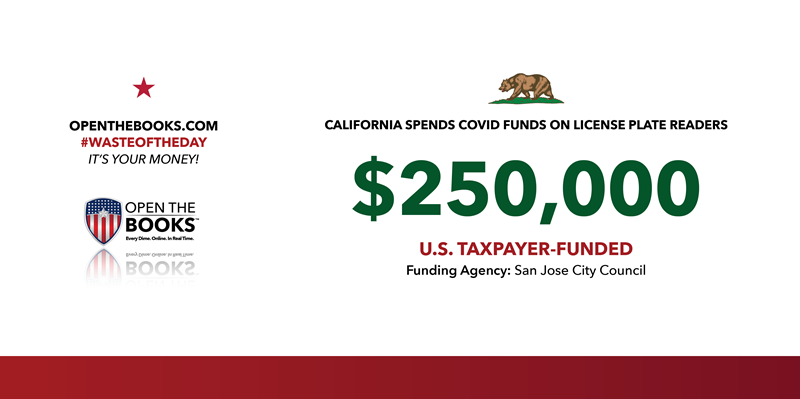
When Congress passed the CARES Act in 2020, it sent funds to states for use on COVID-19 related emergency expenses like testing, sanitation, and personal protective equipment. The states then distributed those funds to municipalities, giving them broad discretion in how to use them, though they were supposed to be for COVID related expenses. Some towns like San Jose, however, had other ideas.
On November 29, 2021, the San Jose City Council unanimously voted to use $250,000 of Covid relief funds to buy license plate readers in an effort to combat rising crime, according to Fox News. License plate readers are small cameras that read license plates, then report that information to police to help find stolen vehicles, record the plate of a vehicle committing a crime, or record the date and time a vehicle was in a specific location.
In a statement, San Jose Mayor Sam Liccardo said, “The expanded investment in license plate reader cameras add to the larger tool set law enforcement uses to apprehend organized burglary rings.” This comes as cities across the nation are seeing an uptick in crime.
Critics, however, dispute that they even work. A study by the Independent Institute and Secure Justice found that “There is not even a moderate degree of correlation between ALPRs and stolen vehicle recoveries” and “Less than 0.3% of ALPR hits (a detected vehicle actively on a “hotlist”) might translate into a useful investigative lead for police.”
Regardless of their efficacy, the San Jose City Council breached the trust of its constituents with this misallocation of funds. If there really were funds left over after fighting Covid (which is unlikely, considering constantly emerging variants), they should have been returned to the state, not used on pet projects like license plate readers.
Prime Minister’s Wizard of “New Zealand, Antarctica, and Relevant Offshore Areas” Paid $368,000
January 5, 2022
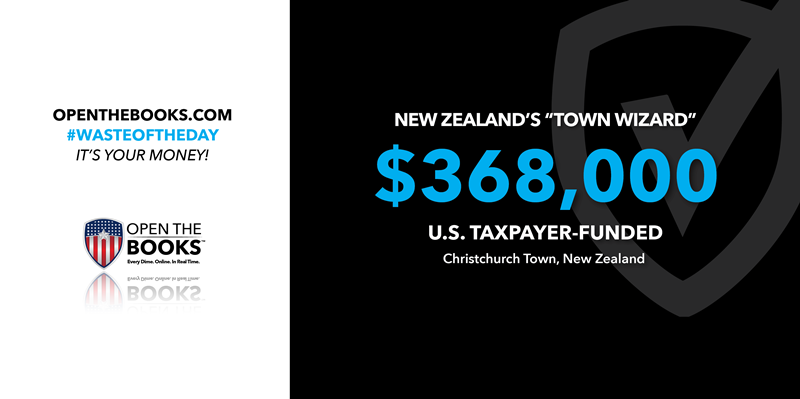
The town of Christchurch, New Zealand officially contracted with the wizard. However, recently, the town has ended its two decades long relationship. The contract stipulated that Channell provide “acts of wizardry and other wizard-like services” like rain dances in exchange for $16,000 per year, adding up to a total of $368,000 over his 23 years of service.
Although the U.S. government doesn’t provide economic aid to New Zealand, America has a large military base at the town of Christchurch. This amounts to a de facto military subsidy of New Zealand. So, New Zealand doesn’t have to spend as much on its own military defense, which frees money up for other spending. For example, spending on wizards.
Sadly, allegedly, the wizard had been slacking in recent years, with few appearances for locals and tourists. He also allegedly made some “off color comments about women” according to The Guardian, expediting his termination. Luckily, the wizard chose not to curse the town that terminated him, instead offering a blessing. “I give children happy dreams, general good health, and I want to make bureaucrats become more human.”
The wizard of New Zealand serves as a reminder that waste isn’t unique to the US, and we should carefully examine how transparent and ethical other countries are before giving them aid.
In 1978, NASA Spent $63 Million Searching for ET
January 6, 2022
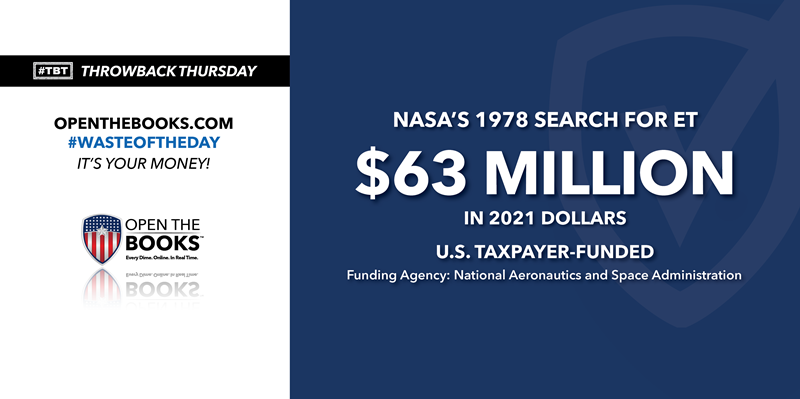
Throwback Thursday!
Many people wonder whether there’s other life outside of Earth, but not many spend $14 million to $15 million to try to find it.
That’s what the National Aeronautics and Space Administration proposed to do for seven years beginning in 1978, spending the equivalent of up to $63 million in 2021 dollars.
That spending earned NASA a Golden Fleece award from Sen. William Proxmire, a Democrat from Wisconsin, who handed out the awards for wasteful and nonsensical spending.
“I am giving my Golden Fleece of the Month award for February to the National Aeronautics and Space Administration, which, riding the wave of popular enthusiasm for 'Star Wars' and 'Close Encounters of the Third Kind,' is proposing to spend $14 to $15 million over the next seven years to try to find intelligent life in outer space,” Proxmire said. “In my view, this project should be postponed for a few million light years.”
The funding was slated to go to a jet propulsion lab in Pasadena, California to conduct “an all-sky, all-frequency search for radio signals from intelligent extra-terrestrial life.”
The purpose was to build an observational and technological framework on which future, more sensitive search-for-extra-terrestrial-intelligence programs can be based, Proxmire said then.
“At a time when the country is faced with a $61 billion budget deficit, the attempt to detect radio waves from solar systems should be postponed until right after the federal budget is balanced and income and social security taxes are reduced to zero,” Proxmire said.
Small Business Administration Distributed Over $3.6 Billion to Potentially Ineligible Recipients
January 7, 2022
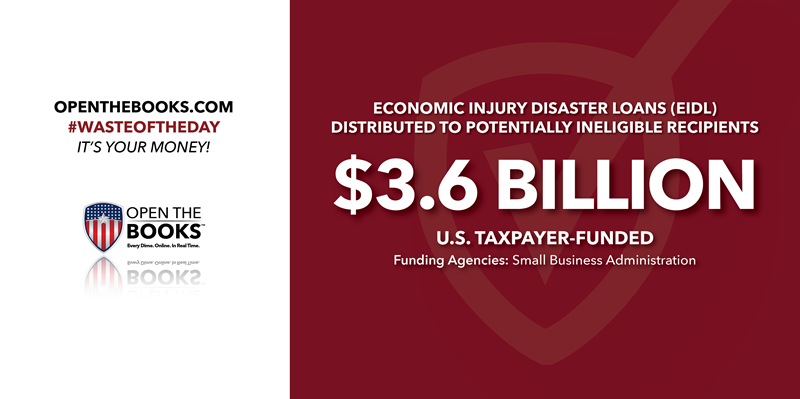
According to a report from the Inspector General of the Small Business Administration to SBA Administrator Isabella Guzman, an estimated $3.6 billion of Economic Injury Disaster Loans (EIDL) were disbursed to potentially ineligible recipients.
The report found that $3.1 billion of the total was in the form of COVID-19 EIDL loans, while another $550 million was in the form of emergency EIDL grants.
The SBA offers a number of programs to assist small businesses, including EIDL, which is used to provide small businesses experiencing difficult times low interest loans from the federal government. However, lax oversight has led to rampant fraud across multiple programs, with the New York Times reporting that up to 15% of its Paycheck Protection Program loans were fraudulent.
Why did the SBA give out so many loans to potentially ineligible recipients? Notably, they didn’t bother to use the US Treasury’s Do Not Pay Working System, a database that helps federal agencies verify eligibility and identify and prevent fraud, waste, and abuse.
The Inspector General used this system to conduct oversight on the 75,180 loans that were made to potentially ineligible recipients, and found that 26,736 loans, or 35%, were already flagged as potential fraud risks in previous IG reports. In other words, the SBA is continuing to ignore already identified sources of fraud.
SBA fraud has run rampant since the start of the pandemic. The law firm Arnold and Porter has a fraud tracker that shows hundreds of charges in the last two years. However, as fraud continues to increase, the SBA refuses to reform its practices to prevent it.
This leaves taxpayers with the bill.
The #WasteOfTheDay is presented by the forensic auditors at OpenTheBooks.com.